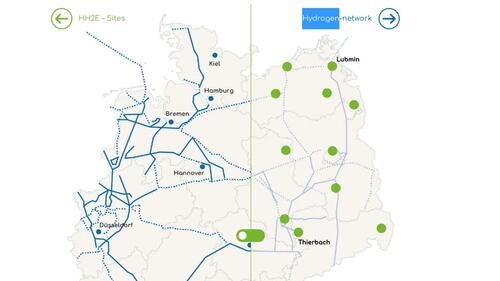HH2E AG Advances Green Hydrogen Production with Major Investments in Lubmin and Thierbach
HH2E AG is significantly advancing Germany's energy transition with the development of two major green hydrogen production facilities in Lubmin and Borna (Thierbach). These projects represent a substantial investment of approximately USD 2.13 billion, underscoring HH2E’s commitment to expanding green hydrogen infrastructure and promoting sustainable energy solutions in Europe.
Strategic Locations: Lubmin and Thierbach
The planned facilities in Lubmin and Thierbach are strategically located to optimize renewable energy resources and support local economies transitioning from traditional industries. Lubmin, situated on the German Baltic coast, is ideal for tapping into offshore and onshore wind farms and solar parks. The Lubmin facility will be integrated with a new generation power-to-X plant that includes a 50 MW alkaline electrolyser and a 200 MWh high-capacity battery. This setup ensures a continuous production of green hydrogen, making efficient use of renewable energy even during periods of low wind or solar power availability.
Thierbach, located near Borna in Saxony, is another critical site where HH2E is setting up a similar facility. This project will contribute to the region's shift from coal mining to sustainable energy production, fostering economic growth, and creating new job opportunities. The plant in Thierbach is designed to produce green hydrogen round-the-clock using a mix of renewable energy sources stored in high-capacity batteries, ensuring a reliable supply of clean energy.
Economic and Environmental Impact
The investments in Lubmin and Thierbach are expected to provide numerous benefits:
- Job Creation and Economic Growth: Each facility will create over 150 jobs, supporting local economies and driving structural changes towards greener industries.
- Green Energy Supply: Both plants will produce green hydrogen using 100% renewable energy, contributing to Germany’s goal of achieving a climate-neutral energy supply by 2050.
- Enhanced Energy Security: The green hydrogen produced will support regional energy security, supplying industries, transport sectors, and potentially other European regions through the expanding European Hydrogen Backbone.
- Environmental Sustainability: The projects are designed with a strong focus on minimizing environmental impact and promoting biodiversity. The plants will use advanced electrolysis technology that not only generates green hydrogen but also produces waste heat that can be repurposed locally.
A Key Role in the European Hydrogen Network
By 2030, HH2E plans to establish up to ten green hydrogen plants across Germany, with Lubmin and Thierbach being the first two major projects. These plants will form part of a nearly 10,000 km hydrogen core network by 2032, laying the foundation for a comprehensive hydrogen infrastructure in Europe. This network will enhance energy connectivity across Europe, integrating renewable hydrogen production with existing and new energy grids.
Latest news
ORLEN launches sales of new aviation fuel: SAF now available at Polish airports
The introduction of SAF at Warsaw Chopin Airport is a major milestone in the aviation sector’s transition toward climate neutrality. Our priority is to establish the conditions necessary for carrie...
Investment in CO2 transportation pipeline project to decarbonize UK cement and lime industry
Sumitomo Corporation has agreed new funding for the development of the CO2 transport pipeline, to support Peak Cluster Carbon Capture project (“Peak Cluster”). Peak Cluster will capture CO2 from fo...
BASF and BACHL complete transfer of Styrodur® business to BACHL
The sale also includes the brand Styrodur®. Approximately 50 employees in production, marketing and sales at BASF SE are involved in the Styrodur business. The affected employees will remain with B...
ORLEN has secured PLN 2.5 billion to finance green investments
The involved investments include the development and acquisition of new renewable energy capacities, further expansion of zero-carbon transport infrastructure (including fast-charging stations for ...
